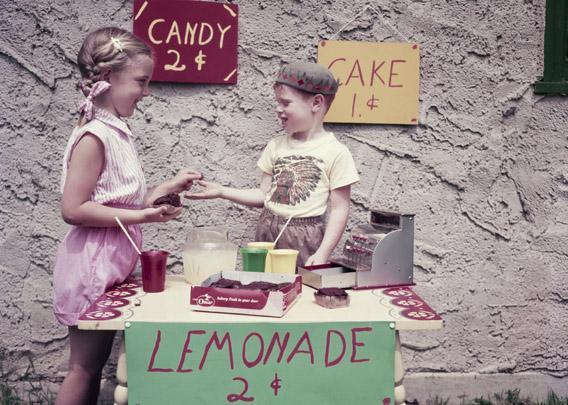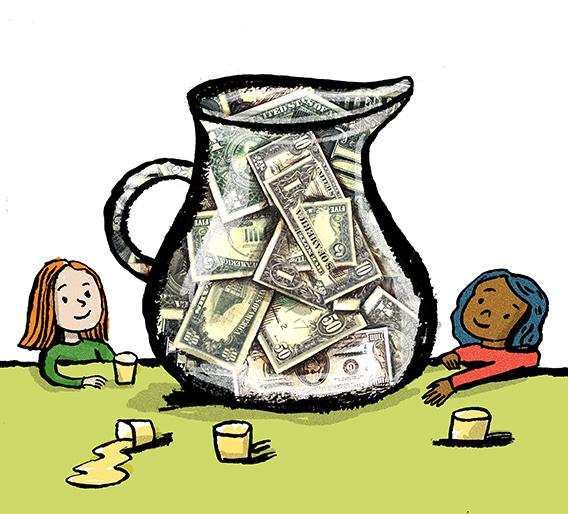A couple of years ago, Verizon debuted a critically acclaimed series of ads called “Susie’s Lemonade Stand.” At the beginning of the first 30-second spot, a young girl named Susie opens a lemonade stand in her front yard; by the end of it, with the help of a Verizon smartphone, she’s a suited mini-mogul commanding legions of employees.
The commercials perpetuated the popular notion that selling lemonade is an invaluable way for children to learn about free enterprise. This idea has been exploited by advertisers for decades: Check out this 1947 General Electric magazine ad featuring a cherub-faced little boy selling “leminade” for 3 cents. (“He’s American business—in miniature,” reads the ad copy.)
The notion of young lemonade vendors as small-business owners is so ingrained that it’s sometimes taken literally by adults: Every summer seems to bring a story of an overzealous police chief or health inspector who closes down children’s lemonade stands for lack of food or resale licenses. During last year’s presidential campaign, the often laughable morning cable show Fox & Friends got in on the act, interviewing 4- and 7-year old sisters Eliza and Clara Sutton, owners and operators of a lemonade stand, as examples of small-business owners who “built it” themselves (contra President Obama’s campaign speech).
The lemonade stand as commercial enterprise has been represented in art, movies, television shows, video games. It is literally part of Norman Rockwell’s America.
It’s also nonsense. My kids had a lemonade stand, and it didn’t look like any version of capitalism I’ve ever seen. If we really want our kids to learn how the modern American economy works, we’re going to have to take off the kid gloves.
Lemonade stands haven’t always been so Rockwellian. Lemon-based drinks were sold on the streets of American cities at least as far back as the mid-19th century. Lemonade stands were staples of church picnics and school fundraisers, but more often than not, lemonade was sold (by children and adults alike) out of necessity. According to historian Steven Mintz, author of Huck’s Raft: A History of American Childhood, in the 19th and early 20th centuries, there were tens of thousands of children who were homeless or deeply impoverished. “They were supporting themselves hand to mouth,” says Mintz. “They did it because the situation was horrible.”
Eventually, beliefs and laws about child labor shifted, leaving most commercial activities off-limits for young people. But selling lemonade was seen as a sign of pluck and a budding, maybe even exceptional, understanding of market forces. Some of the credit (or blame) for that viewpoint must go to Edward Bok, longtime editor of the Ladies’ Home Journal. In his 1922 autobiography, The Americanization of Edward Bok, he claims that as a 10-year-old selling ice water on the hot streets of Brooklyn, he faced stiff competition from other kids. To get a leg up on them, “he squeezed half a dozen lemons into each pail of water, added some sugar, tripled his charge, and continued his monopoly by selling ‘Lemonade, three cents a glass.’ ” We’ve been living with the image of the lemonade vendor as a proto-tycoon ever since.
I don’t know where my kids got the idea to sell lemonade. Perhaps we once bought some from another child. Maybe the parentless bunnies they watched on Max and Ruby had one. One way or another, the image of a lemonade stand lodged in their minds, and they would not let it go: They badgered me about it for over a year. I decreed arbitrarily that they had to wait until they turned 4 and 6, respectively, to set up their own stand.
Their moment finally came on the first warm day of last summer. I outlined the word “LEMONADE 50¢ A CUP” on a sign, and my daughters colored in the letters. This represented their only contribution to the development of their small business. I mixed together two pitchers of lemonade from scratch—one regular, one pink—lugged out a folding table, taped on the sign, and then stood back to let them do their thing.
To be fair, they were ace marketers—they immediately began shouting, “Lemonade, 50 cents a cup” at the top of their little lungs—but I suspect that location may have had more to do with their success than advertising. We set up the stand across the street from our house, in front of a community center with a park and heavily used basketball courts. On that busy corner, their lemonade sold out in less than half an hour. Their business was so popular, so quickly, that they didn’t have to do much to make their money—in fact, they didn’t even have to sell lemonade.
One woman stopped her car, rolled down the window, handed over a dollar, and then refused to take the plastic Solo cup offered to her. An older couple out for a stroll bought a round for three twentysomething strangers who were already on their way to the corner 7-Eleven to get change. The pitchers were empty by the time the three guys got back, but one of them handed my daughter three bucks anyway. And not a single person who bought lemonade from my children would take the change owed them.

An enterprising young boy sets up a stall selling cake, candy and lemonade to his neighbors in 1955. He may be having fun, but he’s learning squat about business.
Photo by Harold M. Lambert/Getty Images
If my children’s experience is in any way representative, lemonade stands are joyfully embraced by adults but they don’t teach entrepreneurship. My kids’ clientele didn’t act like typical customers: They didn’t compare the price and quality of my kids’ lemonade to the price and quality of the lemonade being sold by other kids a few blocks over. They didn’t haggle. And that was the problem. Rather than encouraging an understanding of the value of money and hard work, my daughters’ customers taught them that all they had to do was show up.
In their eagerness to help my daughters learn about private enterprise, they ironically undermined that lesson. Capitalism isn’t sentimental. It doesn’t coddle entrepreneurs. More businesses fail than survive. People think of lemonade stands as representative of pure enterprise, but in enthusiastically supporting them, they deny the true nature of our consumer culture, which rests on both the ideal and reality of competition and ruthlessness.
Something else was going on with my daughters’ customers, too. The sight of small children selling cups of lemonade stirred some sweet emotion in every adult who gladly handed over their dollar bills, from the local dry cleaner to the father driving his daughter home from summer camp. I couldn’t help but think that the pleasure they took in my children’s experience reflected wistfulness for their own lost youth. Mintz, the historian, agrees. “We live in a deep culture of nostalgia, because things change so quickly,” he told me. “We find it very difficult to give our kids the same kind of childhood we had.” A dollar must have seemed like a small price for my daughters’ customers to pay for the comfort of seeing small kids performing the exact same guileless ritual they had once performed in their childhood.
An exchange takes place between youthful lemonade vendors and their adult clients, but it’s not a capitalistic one. For adults, giving kids money is a chance to indulge in rosy-hued nostalgia. As for the kids, they get a chance to play “business,” just as they play dress-up or family. But adults usually fail to remember what the best part of the playacting is for the kids. My children, who were still young enough to think that two quarters add up to more money than a single dollar bill, were far more excited about giving out lemonade than about making money. It made them happy to see adults help them play out their vision of what a lemonade stand should be, cup by delicious cup. The only reason they sold lemonade instead of giving it away for free is that selling is a crucial part of the image of the lemonade stand.
It didn’t matter to them that they made only $14.50, or that I unilaterally decided their proceeds would go to charity. They happily handed over their till, already begging me to let them do it again.
